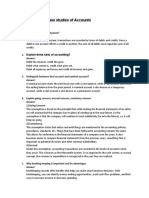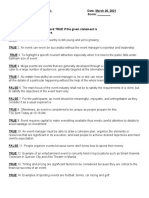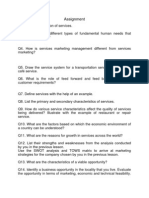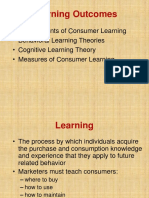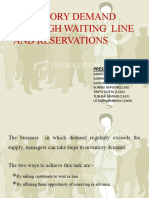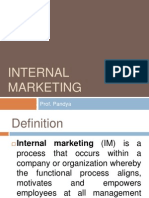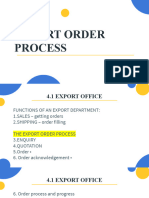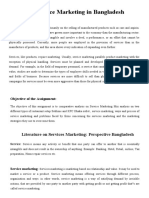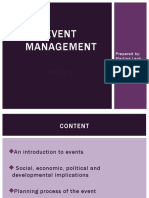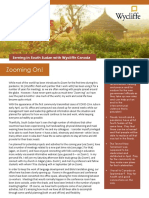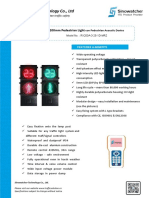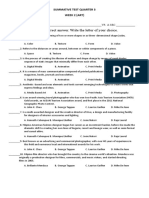Event Management Notes
Uploaded by
Ben SquiresEvent Management Notes
Uploaded by
Ben SquireslOMoARcPSD|9152417
Event Management Notes
Event Management (University of Technology Sydney)
Studocu is not sponsored or endorsed by any college or university
Downloaded by Ben Squires (bensquires17@gmail.com)
lOMoARcPSD|9152417
Event Management
Grading of Assignments
HD: 85-100%
D: 75-85%
C: 65 – 74%
P: 50-64%
Assignments
Assessment Task 1: Critical Review Paper (Individual)
Weight: 20%
Due: 5:00pm Tuesday 31 August
Assessment Task 2: Event Management Plan (Group)
Weight: 30%
Due: 5:00pm Monday 25 October
Assessment Task 3: Exam (Individual)
Weight: 50%
Due: Exam Period
Lecture 1: Introduction to Events
Textbook Chapters 1 & 2
Event Definitions
Defining an Event
“Events are temporary and purposive gatherings of people” (Bladen et al., 2018, p. 3).
“To the customer or guest, a special event is an opportunity for an experience outside the normal
range of choices or beyond everyday experience” (Getz, 2005, p. 16).
“A special event is defined as “those non-routine occasions which have leisure, cultural, personal or
organisational objectives set apart from the normal activity of daily life, whose purpose is to
enlighten, celebrate, entertain or challenge the experience of a group of people” (Shone & Parry,
2004, p. 3).
Special Events
A special event is a one time or infrequently occurring event that provides an opportunity for a
leisure, social or cultural experience outside the normal range of choices (Getz, 2005)
Special events are always planned, always arouse expectations, and always motivate by providing a
reason for celebration (Goldblatt, 1997)
Special events are that phenomenon arising from those non-routine occasions which have leisure,
cultural, personal or organisational objectives set apart from the normal activity of daily life, whose
purpose is to enlighten, celebrate, entertain or challenge the experience of a group of people
(Shone and Parry 2004, p.3)
Events Play a Role in Society
Events are central to our culture
Increased leisure time
Increased discretionary spending money
Leads to spread of public events, celebrations and entertainment
Government’s support and promote events as part of strategies
Corporates & business embrace events
Community groups
Downloaded by Ben Squires (bensquires17@gmail.com)
lOMoARcPSD|9152417
Individuals and families
Players in the Events Industry
Who Organises Events?
Corporate/Business
Professional Associations
Education/Uni/Schools
Media/Advertising
Cultural institutions
Community/NGOs/Associations
Special Interest Groups (sports, outdoors, religion, political, environmental)
Key Industry Players
Event organisations
Event management companies
Suppliers
Venues
Industry associations
Governments
Event Industry Associations
Meetings & Events Australia (MEA) www.mea.org.au
Exhibition & Event Association of Australasia (EEAA) www.eeaa.com.au
International Festivals & Events Association (IFEA) www.ifea.com
International Live Event Association ( ILEA) www.ileahub.com
Australian Festival Association www.australianfestivalassociation.com
Event Typologies
Categorising Events
There are various ways to conceptualise the events industry:
Event size: e.g. local/community events, major public events, mega events
Event themes: e.g. sporting, business, cultural/arts/music
Audience: e.g. B2C or B2B
By profit vs. not for profit
Mega-Events
A “must see” event
Volume exceeds 1 million visitors
Capital costs exceed $500 mil
Extraordinary high levels of tourism particularly international tourism, media / coverage, prestige
and economic impact
Usually undertaken via a bidding process/moves around
Examples: Olympics, Rugby World Cup, FIFA World Cup Qatar
Hallmark Events
Hallmark events become synonymous with a place, city or region (would not be the same if they
moved to/or were replicated in another place)
Closely linked to the spirit or ethos of a place
Success relies on uniqueness, status, tradition, or timely significance
Downloaded by Ben Squires (bensquires17@gmail.com)
lOMoARcPSD|9152417
Developed primarily to enhance the awareness, appeal and profitability of a tourism destination in
the short/long term
“Widespread recognition and awareness”
Examples: Sydney Mardi Gras, Sydney Hobart Yacht Race, Wimbledon, Octoberfest
Major Events
Significant national and international visitor numbers
Significant national media coverage, may have reduced media coverage in other countries
Significant economic benefits
Examples: Sydney Royal Easter Show, Sydney Festival
Minor Event, Local/Community Events
Are held for social and fun, entertainment objectives
Found in most localities
Generally produced in local communities and are targeted at local audiences
Community benefits, thus often supported by local government
Raise participation in sporting, cultural or artistic activities
Examples: Newtown festival, Oyster Bay Art & Craft Festival
Lecture 2: Event Context and Initiation (1)
Overview of Event Planning Process
Event Planning Process
Contextual Factors Impacting the Planning and Delivery of Events
External contextual Factors
1. Legal/regulatory factors
o General Data Protection Regulation (GDPR)
In 2018, data protection legislation came into force an it affects everyone hosting events
and collecting the personal information of EU citizens
o Anti-discrimination Legislation
2. Political factors
o Example: Logies move to Gold Coast after VIC gov. pulls funding for tv awards
3. Physical/environmental factors
Downloaded by Ben Squires (bensquires17@gmail.com)
lOMoARcPSD|9152417
o Example: South Korea aims to host the most eco-friendly Winter Olympics ever (being
powered by wind)
4. Social factors
o Example: Gender diversity bathrooms at events for all forms of gender
5. Technological factors
o Example: Woodford Folk Festival bracelet issued on entry containing a chip to load money
for use around the site
o Example: LED wristband at Coldplay concer
6. Economic factors
7. Organisational factors
Determining the Concept & Scope of an Event
Event Conceptualisation
In creating an event concept or proposal, we need to ask:
WHY - is the event being held?
WHO - is the event directed at?
WHAT - idea will best achieve the goal?
WHERE – what venue will best support the event?
WHEN – what is the best season, day and time?
They WHY
Identifying a purpose
Purpose, vision, missions, goals and objectives to achieve desired outcomes
= guide subsequent management decisions regarding the event
Strategic Management section of this lecture
The WHO
The intended audience:
Tourists; members of a local community; members of a particular industry/profession; individuals
with a special interest; etc.
Event managers need to understand the needs of whatever
markets they are targeting
o Social motives
o Personal motives
o Organisational motives
o Physiological motives
Previous event audience research can condition future event
design decisions
Understanding your customers: what’s important and what’s
not – Top Reasons for Visiting the Sydney Royal Easter Show
Event stakeholders define as those who:
Have an interest in an event and/or
Are involved in the actual planning and organisation of an event and/or
Are financially responsible for an event or have made a significant financial contribution to ensure
the event occurs and/or
Derive a benefit from an event and/or
Are the community, because they are impacted by the event being located within their region
Identifying Stakeholders
Directly Involved Indirectly involved
Event organisers Governments: national, state, local
Downloaded by Ben Squires (bensquires17@gmail.com)
lOMoARcPSD|9152417
Facility managers Consultants
Participants Communities
Spectators Corporate Sector
Officials Tax Payers
Sponsors
The media
Example: Sydney NYE Stakeholders
The Host Organisation The Community
Governments Overall Population
Corporate Sector Interest Groups
Community Sector Minority Groups
Activity, Entertainment, Socialising
Economic, Social, Cultural Interests Celebration of Identity
Sport Promotion – Health Issues
Promotional, Image, Branding… Representation: being part of it?!
The Sponsors The Media
Sponsors as partners Media as contractors, partners, or sponsors
The FIT Events with ‘virtual existence’
Reciprocal engagement Home experiences vs live experiences
Increasing brand awareness The ‘Global Village’
Driving sales Power of media in sports (starting times,
Relationship building between partners and favourable broadcasting…)
clients
The Co-Workers Participants & Spectators
Managers, stage managers, crew, Need for entertainment, physical needs,
gatekeepers, cleaners, volunteers etc. seating quality, amenities, hospitality,
If they are only “doing their job”, they need comfort, safety, security, mixing with the
to be motivated, feel valued and be part of stars… emotions!
the team. Knowledge…HR Meaningful, magical, memorable
A group that event managers have direct experience
influence on ROI – Positive experiences outweigh
negative experiences
The WHAT
Experience design elements need to be linked with the organisation’s
vision/mission/goals/objectives and an understanding of its audience and their needs
Design Elements
Downloaded by Ben Squires (bensquires17@gmail.com)
lOMoARcPSD|9152417
o Theme
o Atmosphere
o Emotional ‘flow’
o Entertainment
o Program activity mix
o Duration/timing
o Level of attendee involvement
o Audience characteristics
The WHERE
Venue choices should be matched with:
o The purpose
o Event theme – atmosphere/style
o Market needs, e.g. comfort, accessibility
o Operational concerns, e.g., catering, staging, power facilities, budget
The WHEN
Key consideration in deciding on the duration and timing/date of the event:
o Nature of audience e.g., senior executives vs. sales staff
o Audience access e.g., holiday periods
o Weather
o Timing of competing events
o Destination’s capacity to ‘absorb’ the event (seasonality)
One more W… The ‘WOW’ Factor
Consider how to give your event a USP (Unique Selling Proposition) or ‘wow’ factor
This is a special feature that attracts attention to your event and makes ut both memorable and
unique
Any of the elements of your event have the potential to become a ‘wow’ factor as long as they are
able to surprise and delight your audience
Event Scope
Scope: a concise and accurate description of the event that is to be created and delivered that
reflects the specified requirement as agreed between the event’s stakeholder(s) e.g.
o Client
o Event management company
o Sponsors
o Funding bodies
EXAMPLE:
An exhibition of between 170-200 exhibitors
Duration- two days (8am-8pm)
Program – Exhibition plus four seminars per day (x30 minutes)
Proposed attendance 2500 – 3000 per day
Market:
o Exhibitors – franchise companies
o Attendees – small independent business owners; individuals seeking to move out of
employment into their own businesses; existing businesses seeking diversity
Issues in Scoping
o Need for stakeholder involvement
o Scope creep
o Scoping as the basis for creating a ‘statement of work
Downloaded by Ben Squires (bensquires17@gmail.com)
lOMoARcPSD|9152417
Lecture 3: Event Context and Initiation (2)
New Events
Concept development and feasibility study
Concept development and pitch based on client brief
Tender response to organisations seeking to create new events
Existing Events
Review, refine or modify existing event
Bid for an event
Respond to tender/client brief for delivery of existing event
Tenders and Client Briefs
Tender and Client Briefs
Tender: inviting parties to submit an offer evaluation of offers selection
Client brief: documents developed by organisations seeking responses as to how a particular
event (e.g. product launch) would be produced by a specialist event management company
Common Requirements for Tender Submissions
Description of the proposed work to be undertaken, including work plan/activity schedule, key
dates and deliverables
Breakdown of costs for services to be provided
Assessment of the risks associated with the work and how these will be managed
Evidence of undertaking similar projects
Skills/experience of staff
Appendices: e.g. references and examples of similar events that have been undertaken
Tender Example (New Event): The Royal Parks
The Royal Parks (TRP) is inviting event organisers to submit proposals to operate a commercial event
on a green field site in Regent’s Park during the four-year period 2013 to 2016. We expect to let
either one or two contracts to professional event management companies to plan, promote and
produce their event annually during the summer months.
The successful company will take all financial risk for their event and will benefit from the
commercial rights, in return for which they will pay agreed fees to The Royal Parks. Bidders must be
able to demonstrate their ability to underwrite the proposed event for the duration of the contract.
Evidence of the financial viability of the event proposed will be a key factor in our evaluation of each
proposal
This opportunity is not appropriate for outdoor music concerts or outdoor music festivals, business
to business events, private events or stand-alone funfairs
Tender Example (Old Event): City of Sydney
The City of Sydney invited quotations from suitably qualified and experienced organisation for the
management of City’s NAIDOC Week Event in Hyde Park.
The bidder will be required to manage all assets of the event including planning, creative content,
community engagement, event operations, booking of vendors and entertainers and event
marketing. The bidder will be required to Liaise with City staff as required
Downloaded by Ben Squires (bensquires17@gmail.com)
lOMoARcPSD|9152417
Bidders are required to demonstrate their capacity, financial and technical capability for completing
the project within the required timeframe, have had previous experience on similar sized projects
and demonstrate a commitment to WHS and environmentally sound principles.
Client Brief Example: Brown brothers
The Client: Brown Brothers
The Client Brief: To create a sophisticated and glamorous signature Summer event in a surprise inner city
Melbourne location and engage existing and potential Brown Brothers customers in a memorable way that
will foster positive and lasting relationships with the iconic Australian brand.
What did the awarded company do?....
The Concept: Brown Brothers Summer of Prosecco Pop-Up Beach Bar
Event Planet created the ultimate summer experience. The floor was covered in over three tons of sand
and a feature DJ desk was built as a sandcastle. On arrival, guests were invited to go barefoot by removing
their shoes at a special check in
Bids and the Bidding Process
Bidding
Event that are ‘mobile’
Organisations/countries/cities/towns can seek to attract these ‘mobile’ events through making a
formal bid
Bidding bodies respond to a given set of criteria outlined in the Candidature document
Will facilitate a site inspection as part of the process
Key Organisations Involved in the Bidding Process
Owners of the event (e.g. sporting body, professional association, corporation) and their local
chapter(s)/representatives/offices
Destination bidding agencies (e.g. state/national governments, major event agencies, convention
and visitor bureaus, tourism bodies)
Tourism and/or event industry suppliers (e.g. conference organising firms, airlines, hotels)
Stages in the Bid Planning Process
1. Identification of events for which bids can be made and their degree of compatibility with bidding
location
2. Identification of host association or society
3. Identification of bid funding sources
4. Development of a critical path for the preparation of the bid
5. Development of an in-depth understanding of the organisation holding the event, the event itself
and the bidding process associated with it
6. Determination of the make-up of the past successful bids and identification of what other
destination/chapters/bodies are bidding for the event
7. Preparation of the bid document (based on criteria, if supplied)
8. Conduct of site inspections
9. Presentation of the bid
10. Lobbying/recruitment of advocated/development of supporting promotional material
Bid Phases and Timeline for a Conference
The bid was for a 3 day medical conference to be held in Sydney, estimated to attract 8, 000 delegates
2004 – it is determined the next opportunity for Sydney to host the conference (based on rotation)
is 2013
Mid 2006 – investigating stakeholder support and potential interest in forming a bid team
Downloaded by Ben Squires (bensquires17@gmail.com)
lOMoARcPSD|9152417
February 2007 – Bid committee formed
December 2007 – bid document and video submitted
February 2008 – receive notification that Sydney has been shortlisted from 5 Asia Pacific cities
April 2008 – Sydney hosts 7 members of the international committee for a one-day site inspection
June 2008 – bid presentation in Chicago. Sydney awarded the rights to host the 2013 conference
Example: Bidding for Olympic Game
What costs do cities incur for hosting the game?
Cities must first invest millions of dollars in evaluating, preparing, and submitting a bid to the IOC. The cost
of planning, hiring consultants, organizing events, and the necessary travel consistently falls between $50
million and $100 million. Tokyo spent as much as $150 million on its failed 2016 bid, and about half that
much for its successful 2020 bid, while Toronto decided it could not afford the $60 million it would have
needed for 2024 bid.
Key Background Data for Developing Bid Documents
An understanding of the event owner or sanctioning body
The proposed objectives for the event
The bid criteria
Whether there is a set pattern for the rotation of the event
Who commonly attends the event
How many people attend
What sates/countries attendees are likely to come from
The proposed event dates
Whether the dates are flexible or clash with other events in the bidding city
The nature and characteristics of the event
Competitor analysis
Common Components of a Conference Bid
Personalised letter to the client, or sanctioning body
Letters of support
Profile of the group making the bid – bid committee/host organisation(s)
Support already obtained for the bid
Advantages over competitors
Summary of the event concept
Details of city’s track record in hosting events/conferences
Details of the plan: venue, facilities, investments, timing, scheduling, programming etc
Forecast of attendance
Promotional plan
Assertion of financial feasibility and budget
Forecast of impact and contingency plans
Common Reasons Bids Fail
Failure to address the bid criteria provided by the organisation
Lack of research concerning key success factors
Key decision makers not identified and lobbied
Bid failed to enthuse and inspire confidence
Bid document too complex or technical, or did not present well
Event Feasibility
New Events
Concept development and feasibility study
Downloaded by Ben Squires (bensquires17@gmail.com)
lOMoARcPSD|9152417
Concept development and pitch based on client brief
Tender response to organisations seeking to create new events
Existing Events
Review, refine or modify existing event
Bid for an event
Respond to tender/client brief for delivery of existing event
Functions of an Event Feasibility Study
Helps to analyse the event concept in more depth, providing greater clarity, defined objectives and
key stakeholders
Allows for better, more informed decisions on the event concept at a logistical, financial, resources
and marketing level
Reduces the risk of a wasted investment in – time, resources and money
Helps reduce the event project planning time for the event – should it go ahead
Provides a platform for seeking financial support
What a Feasibility Study is NOT:
Intended to identify new ideas or concepts for an event
A business plans
To be conducted to support a desire that an event to be successful; rather it should be an objective
evaluation of an events chance for success
Determining if an event should proceed, instead it provides the basis for such a decision
o Will the benefits justify the risks?
What does a Feasibility Analysis Involve? (1)
What does a Feasibility Analysis Involve? (2)
Considers:
Financial requirements
Venue requirements and capacities
Managerial and employee skill needs
Availability of volunteers
Economic impact on the local region
Environmental impact
Infrastructure requirements
Legal requirements and potential legal problems
Political support or opposition
An Event Feasibility Study Addresses:
Downloaded by Ben Squires (bensquires17@gmail.com)
lOMoARcPSD|9152417
Market feasibility: projected demands (no. of attendees based on analysis of the market),
competition (number, quality differences, customer loyalty), market trends affecting demand
Financial feasibility: estimated costs vs projected return, sources of revenue/budget, financing
model, available financial support (grants, sponsorship)
Operational feasibility: HR needs vs availability at given time/place (skills, quantity), venue
requirements & capacity, infrastructure/ accessibility, equipment/services (e.g. F&B, outsourcing)
+Scheduling feasibility: is there sufficient time to plan and implement the event
Other: political, economic, social/cultural, technological, environmental, legal/regulatory contect;
e.g. sensitivity of concept to change in any exchange rates
PESTLIED Model
Political C-PESTEL
Economic Competitive
Social Political
Technological Economic
Legal Sociocultural
International Technological
Environmental Environmental
Demographic Legal
Where do I find information to help me prepare a feasibility analysis?
Websites, reports and other publications by similar events (your competitors)
Generic data on population (and subgroups), economy, workforce
Industry publications, newsletters, websites, reports on market trends, competition, HR situation
Other news sources focussing on issues related to your type of event
Potential sponsors’ websites
Government websites on various levels (e.g. council) to check for grant schemes, legal
requirements, transport infrastructure
Venue website to check for services, equipment, accessibility
Existing Events: Combining SWOT & C-PESTEL
SWOT includes internal elements (strengths & weaknesses) and external elements (opportunities
and threats).
C-PESTEL identifies and analyses the competitive, political, economic, socio-cultural, technological,
environmental and legal climate around an event (external).
1. Establish SWs to clarify your own position
2. Conduct C-PESTEL to screen/research the environment
3. Identify specific OTs taking into account the external climate
4. Develop strategies to address OTs
Existing Events: Example
Analysing opportunities and threats in the competitive, political, economic, socio-cultural,
technological, environmental and legal environment
Examples for the HappyTown Culture Festival are:
o Multicultural and vibrant place; many film makers and writers live in area; among the
wealthier post codes in the city; wealthy surrounding area; young beach culture; council
supportive of festivals; lots of restaurants and clubs; experience with beach events and
markets.
o Anti-event approach of some residents; parking issues; no large companies headquartered in
area; lack of potential sponsors; legal and environmental issues when operating at the
beach.
Strengths
Downloaded by Ben Squires (bensquires17@gmail.com)
lOMoARcPSD|9152417
o Competent and educated General Manager – MM Event Mgt
o Positive cash balance from last year’s festival
o Access to large number of enthusiastic volunteers
o Professional relationships with many local event and cultural organisation and individuals
o Supportive Council
Weaknesses
o Concentrated on Northern Beaches
o Lack of public transport
o No resource input from the local council
o Parking options
Opportunities
o Include emerging community groups in event to showcase their activity and provide
additional attractions for community
o Extend to include some local restaurants and food outlets to increase attraction and local
/social dimension to event
Threats
o Vibrant town activities provide alternate options for community
o Weather (nature of event does not easily allow for rescheduling)
o Local community complaining about drunken clients, parking, congestion and noise
Lecture 4: Event Planning (1)
Strategic Planning
Strategic Planning
Vision: What the event aspires to be
Mission: Describes the event’s purpose
Goals: The strategic plans, the things the event would like to achieve
Objectives: The way to obtain your gaols
Characteristics of Vision Statements
Long term
Describes a desired future outcome/state
Serves as a wider focus
Motivational
Need not be written, must be understood and shared
Sample Vision Statements
Adelaide Fringe Festival – To be the leading open-access fringe festival in the world
Freeze Frame (Film Festival) – strives to be an international leader in providing enriching cinematic
experience through the delivery of diverse and innovative programming that educates, insires and
empowers children and youth.
Colorado Dragon Boat Festival – will be recognised throughout Colorado as the state’s premier
organisation celebrating and promoting the culture, contributions and accomplishments of Asian
Pacific American communities
Characteristics of a Mission Statement
= Event’s purpose and answers the question: What do we stand for and what are we trying to achieve?
Key aspects:
State the event’s purpose
Identify its beneficiaries and/or customer groups’
Downloaded by Ben Squires (bensquires17@gmail.com)
lOMoARcPSD|9152417
Indicate the broad nature of the event;
State the overall philosophy/values of the organisation conducting the event;
Be motivational and achievable
Sample Mission Statement
Freeze Frame (Film Festival) – provides educational opportunities for children and youth to explore
the art of filmmaking through screenings of international film and video and hands-on workshops in
a multilingual environment
Value Statements
= Event’s core beliefs
Stand alone or included in mission
Connect with the event’s audience
Make stakeholders aware of the priorities
Guide decision making
Sample Value Statement:
The Oregon Shakespeare Festival:
1. Excellence
We believe in constantly seeking to present work of the highest quality, expecting excellence from
all company members
2. Inclusion
We believe the inclusion of a diversity of people, ideas and cultures enriches both our insights into
the work we present on stage and our relationships with each other
3. Learning
We believe in offering company members, audiences, teachers and students the richest possible
learning experiences.
Purpose Statements
For events that are:
Straightforward/non-complex
Have a small number of stakeholders and/or
Are one-off events
Examples:
University Open Day – Grow student enrolments by engaging, informing and exciting potential
students (and their families) regarding the university’s capacity to meet their ‘whole of person’
needs
Brain Awareness Week – Brain Awareness Week is an international effort organised by the Dana
Alliance for Brain Initiatives to advance public awareness about the progress, promise, and benefits
of brain
Goals
Goals provide direction to those engaged in the event
They expand on the mission statement
For some events, the step of creating goals prior to setting objectives might not be considered
necessary
Sample Goals
Blues at Bridgetown (Blues Music Festival, Western Australia)
o Bring recognised national & international artists to perform and conduct workshops;
o Conduct workshops for local, regional and WA artists;
Downloaded by Ben Squires (bensquires17@gmail.com)
lOMoARcPSD|9152417
o Provide a diverse range of Blues styles;
o Operate the activities in a business like manner;
o Maximise funding opportunities;
o Maintain local community and business involvement
Objectives
Quantify the progress towards an event’s goals
They set performance benchmarks
They should be SMART:
o Specific
o Measurable
o Achievable / Agreeable
o Realistic / Relevant
o Time-specific
Types of event objectives
Attendance/participation
Program
Economic
Quality
Organisational Structures
Organisational Structures
Indicate power and communication channels
Establish formal relations between departments/ committees/individuals
Impact on efficiency
Provide a visual representation of how tasks will be groups
Are expanding and shrinking rapidly in event management
Example: Australian University Games
Two managers are initially employed to plan the Games
In the lead up to the Games, the structure expands to include five additional functional managers
Nine other full time staff are later appointed to assist these managers
Four hundred volunteers are appointed as the event approaches
Organisational structures for events
Choice of structures:
o Simple Organisational structure
o Network
o Functional
o Program-based matrix
Simple Organisational Structure
1. Low level complexity
2. Decision making centralised
3. Event manager has total control
Multiorganizational Approach: Network Structure
Multi-Organisational Approach – Outsourcing
Focus on ‘Management and Coordination’
Downloaded by Ben Squires (bensquires17@gmail.com)
lOMoARcPSD|9152417
Advantages: small amount of full-time staff; external expert knowledge; accuracy in costing; “quick”
decision making
Important: quality control issues; team-feeling; admin work
Functional Structure
Departmentalise tasks
Opportunity to specialise
Can be added to as event/organisation develops
Can be problematic for coordination
Establishes ‘territorialism’
Tennis Tournament
2003 Rugby World Cup
Matrix Structure
Program-based; Breakdown into projects and functions
Mainly used at large-scale major / hallmark / mega events
Advantages: functional expertise across the venues; less decision-making bottlenecks /
communication issues; allows groups to engage directly with tasks
Important: focus on good coordination across venues by
senior management
Symptoms on Ineffective Structures
Too many management levels = high costs; complexity;
inflexibility
Too many coordination and committee meetings
Downloaded by Ben Squires (bensquires17@gmail.com)
lOMoARcPSD|9152417
Too many unresolved or unresolvable conflicts
Non-achievable of reasonable objectives
Inability to respond/adapt to changes un environments
Events as Projects
Events as projects
A project is a temporary group activity designed to produce a unique product, service or result.
- A project is temporary in that it has a defined beginning and end time, and therefore defined scope
and resources.
- A project is unique in that it is not a routine operation, but a specific set of operations desined to
accomplish a singular goal
Projects can be defined similarly to events as:
‘A temporary endeavour undertaken t create a unique product or service’
Events & projects are both: Events differ from projects in:
- Temporary - Executed and consumed at the same time
- Unique - Co-created with participants and
- Executed by teams adjustments can be made during the
- Outcome based execution
- Time sensitive – executed on specific dates
that cannot be adjusted
Project management
Project management is the application of knowledge, skills and techniques to execute projects
effectively and efficiently (The Project management Institute, 2015).
Project management is a system that describes the work “before the event actually starts, the event
itself, and finally the shutdown of the event” (Allen, Ot’Toole, Harris & McDonnell, 2008, p.160)
Benefits of a Project Manager Approach to Events
Systematic, consistent, transparent
Ensures systems and processes are independent of any one person
The approach is recognised and understood
Documented approach = accountable approach
Makes work of event team visible and validated
Potential Issues in Project managing Events
Qualification/forecasting of all the steps involved in project management due to complexity
(particularly with large scale events)
Multiple venues operating concurrently
Immovable event date
Budget certainty (e.g. when sponsorship is involved)
Procurement – need to identify, source, and ensure timely arrival of goods/services
Different requirements of stakeholder groups + number of stakeholders involved
Engagement with requirements of event ‘owner’/compliance with bid document
Media and community scrutiny associated with planning and delivery
Work Breakdown Structures (WBS)
Work Breakdown Structures
Downloaded by Ben Squires (bensquires17@gmail.com)
lOMoARcPSD|9152417
Events can be viewed as a series of tasks (or related ‘packages’ of work). A useful method of
organising these tasks is called the Work Breakdown Structure
A WBS involves breaking an event down into major tasks. These tasks are then further broken down,
a process that continues until a level of detail has been reaches that is deemed appropriate for the
needs of an events organisers.
Example 1: National Athletics Championship
First Level WBS
Second Level WBS
Third Level WBS
Example 2: Balloon Festival
Downloaded by Ben Squires (bensquires17@gmail.com)
lOMoARcPSD|9152417
Benefits of a WBS
Increases the probability that all tasks are identified
Assists with work allocation and control of work execution
Allows for a resource list to be created
Facilitates decision making i.e. which tasks should be done ‘inhouse’ and which should be
contracted out
Task based resource worksheet
WBS and Statement of Work (SOW)
WBS’s are key to understanding the scope of what is required to deliver an event and in
constructing a statement of work (SOW)
A SOW includes:
o Event mission/vision/objectives
o Scope of work
o Stakeholders involved and key responsibilities of each
o Draft schedule
o Draft budget
The SOW is a baseline document for the planning process
WBS & Task Scheduling
Following on from WBS
o identifies need to be completed and ordering/priorities of tasks
Types of Scheduling tools:
o Schedules
o Gantt Charts
o Event Running Sheets
Lecture 5: Event Planning (2)
Event Budgeting
Case Study: Peats Ridge Festival
Case Study Tropfest
Downloaded by Ben Squires (bensquires17@gmail.com)
lOMoARcPSD|9152417
Key Terminology
Financial accounting vs. Management accounting
Income statement / Profit and loss account
Balance sheet
Cash Flow
Revenue = Income
Expenses = Cost = Expenditure
The Roles of Budgets
Budgets act to forecast event’s financial future and as such influence the decision to proceed or not
to proceed with a given event
Is the event financially viable? Will the event result in adequate ROI (Return on Investment)?
Budgets serve to identify expenditure and income sources
Budgets act to predict a surplus or loss
Budgets act as a control mechanism
Budgets are ‘living’ / evolving documents
Steps in Preparing an Event Budget
1. Research and scenario building
2. Determine an appropriate level of budgeting
3. Create a budget and have it approved
4. Monitor expenditure against budget
5. Review budget post event
Case in point: The Blueprint Festival
“We set out to run this festival with the best intentions possible. It wasn’t until after the festival that we
realised we didn’t have enough money to pay everyone”
- Sold tickets cheaper then they should have
- Only made ¼ of what they counted on from food and sales
o Blames lack of security – allowed alcohol to be brought on site
o Some patrons stole alcohol from organisers and tried to sell to market stallholders
1. Research and Scenario Building
Possible sources of information:
o Last year’s budget and associated review outcomes (if the event is a recurring one)
o Budgets of similar events
o Market feedback from previous years
o Quotations from suppliers
o Feasibility studies
Considerations in budget development
Taxation requirements of country (e.g. GST, VAT)
Market price sensitivities
Changes (actual and predicted) in the economic environment, e.g. Exchange rates/inflation
Period of time to event delivery
Current and potential revenue streams
Contingency allocation
Potential event revenue streams
Downloaded by Ben Squires (bensquires17@gmail.com)
lOMoARcPSD|9152417
Tickets / registration Broadcast / streaming rights
Grants / donations Raffles / competitions / auctions
In-kind support Parking
Merchandise Food and beverage sales / Stallholder fees
Advertising And more….
Sponsorship
Potential event expenditure
Food and beverage Printing
Administration Graphic design
Wages and Salaries, HR training Decoration
Insurance Cleaning
Permits Marketing/promotion
Accounting Hospitality
Infrastructure & equipment Travel & Accommodation
Venue hire Security
Lighting, sound & vision Risk, emergency services
Staging Contingency % or $
Entertainment And more..
Understand your Costs
Fixed vs. variable costs
o Fixed = do not change with the number of people attending an event
o Variable = change with the total number or people attending
o Semi-variable/step-fixed = fixed assuming specific number of attendees, variable if
significantly less/more attendees than expected
Fixed costs + Variable costs = Total Costs (for a specific number of attendees)
Direct vs Indirect costs (overhead)
o Direct = costs directly associated with running the event
o Indirect = event support costs e.g. Running of the event organisation (office space rental,
computers & software, etc.)
Break-even Chart
Applied Scenario Building: Considerations for a Music Concert
Downloaded by Ben Squires (bensquires17@gmail.com)
lOMoARcPSD|9152417
Considerations in estimating demand, costs, pricing levels and extent of risk:
o CD sales / downloads / position in the charts
o Time since artist’s last visit to Australia
o ‘Premium’ status of artist e.g. Pink
o Currency (current and projected AUD)
o Artist(s) fee (fixed, percentage of total income – ticket sales and merchandise, percentage of
net profit)
o Fee payment schedule (e.g. 50% of guaranteed fee on signing)
o Performance results (financial) of artist on recent concert tours
o Size and requirements of production (venue costs, staging, supplier services – prices of these
may rise between signing and delivery)
o Intermediary charges (i.e. ticket agencies)
o Venue configurations by pricing levels (ticket scaling)
o Extent of discounting (e.g. group sales)
2. Establishing an appropriate level of budgeting
Single budgets vs. Multiple budgets
o If an event has multiple components it may be preferable to treat each event element
separately within an overall master budget
o Each major expenditure area should also have its own sub-budget
Marketing sub-budget components
Advertising
o Radio
o TV
o Newspaper
o Internet
o Magazines
Design
Printing
Mail outs
Website/ social media
o Creation
o Maintenance
Creation/purchase of mailing lists
Media hospitality
Media monitoring
Evaluation
Other?
3. Budget establishment and approval
Once steps 2 and 2 have been completed, formal budget(s) need to be prepared
Once a budget has been prepared it is approved by whomever has overall responsibility
Changes made to the budget may also need approval
Sample Budget
Music Festival – Musica Viva
Downloaded by Ben Squires (bensquires17@gmail.com)
lOMoARcPSD|9152417
4. Monitoring Expenditure
Various approaches can be employed for this purpose, including:
Monthly statements of income and expenditure
Purchase orders
Regular budget meetings
Restrictions on expenditure and over budget
Comparisons with previous years
Monitoring Ticket Sales
5. Budget Review
An evaluation of the budget post event allows an event manger/organising body to see:
o Areas where under-spending/overspending took place
o Areas where income was up/down
o Overall, how accurate the projection process was
o Performance against previous years
o Overall financial position of event going forward
Information from the review process can be used to:
o Alter future budget projections to make them more ‘realistic’ or redirect financial resources
Downloaded by Ben Squires (bensquires17@gmail.com)
lOMoARcPSD|9152417
o Make the argument for tighter expenditure controls & identify in which costs must be
contained
Example: Mardi Gras Financial Reports
Issues in Event Financial Management
Cash flow – Example (cash inflow)
Cash flow: Approaches to managing cash flow
Encouraging early registration/ticket purchase via means such as discounts
Ensuring monthly expenditure and income is identified in a cash flow statement
Negotiating deposits
Monitoring accounts receivable
Requesting extended payment terms from suppliers
Requesting early drawn down of any funds raised from external sources e.g. grants
Having the event underwritten by another organisation
Loan(s)
Transparency
Reporting requirements to public funding bodies
Budget Blowouts
Reducing the risk of budget blowouts
o Regularly update the budget to act as true record of the financial ‘status’ of the event
o Lock suppliers into contracts
o Include suppliers into contacts
o Include an amount for contingencies
o Beware of the disconnect between ‘creatives’ and budgets/financial matters
Downloaded by Ben Squires (bensquires17@gmail.com)
lOMoARcPSD|9152417
Responding to budget blowouts
o Avoid reducing costs by targeting ‘core’ event elements (e.g. venue, food/beverage). Instead,
identify items that will not directly impact the core event experience
o Transfer costs to other organisations e.g. sponsorship arrangements; use of volunteers
Looking back and looking forward
Budgeting is a process involving a number of key steps
A key driver of event success is the ability to monitor and control the event budget
Remember it is easy to end up with a small fortune from running events if you start off with a large
one
Risk management is important
Lecture 6: Event Planning (3)
Managing and Developing the Event Workforce
What is the primary function of event HR planning and management?
To ensure an event “is adequately staffed with the right people, who are appropriately trained and
motivated to meet its objectives” (Bowdin, Allen, O’Toole, Harris & McDonnell, 2012, p.323)
Defining HRM
HRM – the process of matching people to jobs and developing a satisfied and effective workforce
HRM is central to planning – high costs
HRM has a direct impact on organisational performance
“People decisions are the ultimate – perhaps the only – control of an organisation. People determine the
capacity of an organisation. No organisation can do better than the people it has.” (Peter Drucker, 1990).
Who is the Event Workforce?
It is the task of the event/HR manager to manage all the people involved in the event= the event workforce
This includes people involved at all stages of the event planning process
Human resource challenges specific to events (1)
Pressure associated with fixed delivery dates
Pulsating nature of organisational structures
o Quick growth and contraction
o Difficulty in attracting paid staff for short periods – job insecurity
o Short time line for staff hiring and training
o Need to shed staff quickly
Event staffing – “Pulsating”
Pulsating nature of event recruitment – Commonwealth
Games Melbourne
Downloaded by Ben Squires (bensquires17@gmail.com)
lOMoARcPSD|9152417
Human resource challenges specific to events (2)
Involvement of volunteers
o Sourcing
o Quality control and supervision
o Training and motivation
Wide range of skill/knowledge requirements
Need for teamwork
Human Resource Planning Process
Human Resource Planning process
1. Establish Objectives & Strategies
o Human resource management strategy for an event should seek to achieve specific
outcomes, for example:
Growth
Cost containment
Improved quality – e.g. reduction in queuing times
Improved organisational effectiveness – e.g. through cross training
Enhanced performance as regards legal/environmental/safety responsibilities
2. Staffing
o Identify all tasks (WBS) and estimate number of people required
o Job analysis – what skills/knowledge/experience will be required to perform the job?; How
will the job be related to other jobs?; and what training will be required?
o Job description & specification – title of job; duties/responsibilities/authority of position;
skills/knowledge/experience/personal attributes; full/part-time; volunteer/ contractor;
salary/rewards; relationships with other positions; and how will performance in the position
be assessed.
o Estimating the number of staff/ volunteers needed for an event
WBS
Number of venues/scale of event
Outsourcing levels
Downloaded by Ben Squires (bensquires17@gmail.com)
lOMoARcPSD|9152417
Skills/expertise needed
Reference to similar events
Human resource strategies adopted
Industry norms (e.g. 1-100 patrons for security staff)
Use of technology e.g. electronic ticketing
Service levels (e.g. desired queuing times)
3. Establish policies & procedures
o Policies and procedures provide a framework for action/decision making
o They serve to:
Provide guidelines for managers/supervisors
Assure staff/volunteers they will be treated fairly
Provide a basis for decisions (‘manuals’)
Serve as a reference point for problem solving
4. Recruitment, Selection & Induction
o Is about attracting the ‘right’ potential candidates to the ‘right’ job offerings:
o Communication with target groups:
Advertising; employment agencies; word of mouth; social functions; stakeholders;
educational institutions
o Sources of staff:
Other events, consultants, secondments, educational institutions, government
programs, sponsors
o From applicant pool
o Systematic – using appropriate tools and guidelines
Screening e.g. job applications; resume; volunteer registration
Selection policy – how will candidates be assessed? Who will decide? What selection
techniques will be employed?
Interview – checklists based on job criteria
o Aim to avoid the costs associated with poor selection
o Appointment – contracts; letter of appointment; volunteer statement of rights and
obligations
o Make new employees welcomed and values
o Induction program should provide:
Event information; organisational culture, history and working arrangements
Introductions; tours
Overview of training programs
Induction kit (welcome kit) – which might include:
Annual report; organisational chart; venue map and program; a staff list with
key contracts; list of sponsors; list of stakeholders; name badge; uniform
Legal Obligations
Event managers must be aware of their legal obligations to employees:
o Salary and conditions (state/territory depts, of industrial relations)
o Equal Employment Opportunity (Australian Human Rights and Equal Opportunity
Commission)
o Dismissal (Australian Industrial Relations Commission)
o Safety in the Workplace (Workplace Safety Australia)
5. Training and Professional Development
Downloaded by Ben Squires (bensquires17@gmail.com)
lOMoARcPSD|9152417
o Training: provision of specific job skills or knowledge that allow people to perform or
improve current job performance
Vs.
o Professional Development: the acquisition of new skills or knowledge that prepares
someone for future job responsibilities
o What training is needed?
Training needs assessment
Identify gapes between current performance and desired performance
Look at job description; performance appraisal results; staff feedback
o Training options include:
Existing staff/volunteers as trainers – in house
Sending staff/volunteers to outside bodies for training
Commissioning outside bodies to provide training
6. Supervision & Evaluation
o Key task of a supervisor is performance appraisal
o Evaluating performance in relation to set goals
What does the job require?
What does the employee need to do to achieve job requirements?
Is there evidence of this achievement?
o Policies & procedures can guide practice in this area
o Techniques:
Self-appraisal in conjunction with manager appraisal
Rating scales – set criteria relating to job description
o (Motivation) Rewards for Staff
Pai Staff:
Salaries, bonuses, profit sharing, incentives
Equity (a share of ownership)
Promotion to other jobs or events
Perks (use of car, equipment, trips etc.)
Volunteer Staff:
Free admission to event, food & beverages
Souvenirs of event
Social occasions e.g. closing day parties
Certificates of appreciation & public acknowledgment
Moving up volunteer hierarchy
Meeting celebrities/performers
Personal thanks from managers, directors, sponsors & VIPs
Professional development in new skills
7. Termination, Outplacement and Reenlistment
o Termination – legal issues such as laws against unfair dismissal
Fixed term appointments for staff/volunteers with a need to reapply each time an
event is conducted
Use of job descriptions / performance appraisals
o Outplacement – provision of assistance to staff/volunteers seeking new positions
o Re-enlistment – maintenance of contract with past staff/volunteers and provision of
incentives (e.g. opportunities for volunteers to progress to more interesting roles with
greater responsibility); recognition (e.g. certificates for appreciation, parade of volunteers,
after parties)
o Surveys / debriefs to establish why staff / volunteers leave
Downloaded by Ben Squires (bensquires17@gmail.com)
lOMoARcPSD|9152417
8. Evaluation & Feedback
o Periodic review is required to determine the effectiveness of HR process – time should be
allocated for this task and feedback sought from appropriate staff/volunteers/ committee
members
Event Volunteer Management
Who are volunteers?
‘One who offers their services to the organisation of their own free will and without expecting
remuneration. Has personal goals that can be attained through volunteering’ (Getz, 1997, p. 198)
Volunteer traits:
o Usually enthusiastic about event itself
o Often lack experience & specific training (not always)
o Prefer short term responsibilities
o Many are artistically creative rather than technically oriented and want to have fun
o Are not economically dependent on the event, therefore easier for them to quit
Benefits for events
A more personal approach to customer service
Team of people passionate about your event
Organisation can develop skills in the community
Frequently saving costs
Give back to the community
Connect with the local community
Why volunteer?
Reasons why volunteers leave events
Workload
Lack of appreciation of contribution
Problems with overall event organisation
Disagreement with changing goals/ideology of event
Lack of sense of community amongst volunteers
Family responsibilities
Event becoming too large
Inability to make decisions regarding their own position
Dislike of responsibilities
Motivation
Motivation is key
Downloaded by Ben Squires (bensquires17@gmail.com)
lOMoARcPSD|9152417
Motivated staff are committed, enthusiastic, energetic and dedicated to achieve goals
Differences in motivation:
o Intrinsic factors
o Extrinsic factors
What are people’s needs, strengths and goals
Herzberg’s To-Factor Theory
Rewards, recognition & retention
Rewards and recognition crucial to maintain volunteer commitment
Staff losses mean knowledge and skills are lost – costly to replace
Rewards are a nice way to end an event – and they can provide motivation for others
Lecture 7: Event Planning (4)
Venue Selection, Layout and Design
Supplier Selection, Contracting and Management
Traffic and Transport Planning
Lecture 8: Event Delivery & Shutdown
Event Control & Monitoring
Event Scheduling Tools
Site and Event Shutdown
Knowledge Management
Event Evaluation
Lecture 9: Critical Issues in Event Management (1): Risk & Crisis Management
Downloaded by Ben Squires (bensquires17@gmail.com)
lOMoARcPSD|9152417
Risk Management
Why do we need Risk Management in events?
For clients
o Clients want to know that event managers are able of exercising appropriate level of due
diligence
o If a client hires a degree qualified event manager they expect they are aware of risks
involved and control risks on behalf of them and justify decisions with documented evidence
For coroners
o Have access to historical data regarding fatal incidents
o Have begun to publicly note where recommendations have not been followed
o Are recommending criminal prosecution where a Person Conducting a Business or
Undertaking (PCBU, i.e. An event manager) fails to learn from past incidents
Risk Management AS/NZS ISO 31000:2018
An Australian and International Standard recognised by the courts as legitimate process to analyse,
make defensible decisions and deal with risk.
Key objectives of industry standard are:
o Provide a tool to reduce likelihood of significant incidents
o Provide demonstration of logical and systematic decision making
o Provide documentation as supporting evidence
o Ensure the events industry takes a leadership position to avoid outside parties imposing
inappropriate regulations or legislation
Integrating Risk Management
‘Risk management must be integrated into the culture of the organisation and evident in all aspects,
if all risks are to be well managed.’ (HB246:2004 p29), by
o Establishing a philosophy and creating the right culture
o Integrating risk management into planning at all levels
o Feedback and improvement
Responsibility of Event Managers
The decisions you make must follow a process that is recognised as best practice – the Australian
Standard
Casual decision making is not appropriate for event organisations. You must manage:
o Time pressures
o Financial pressures
o Ethics and emotions
Risk assessment is a cost benefit analysis. It considers costs as well as unrealised liabilities
Why document?
To provide evidence of a systematic approach to risk identification and analysis
To provide a record of risks and to develop the organisations knowledge and database;
To provide an accountability mechanism and tool
To provide the relevant duty holders – decision makers with a risk management plan for approval
and subsequent implementation
To facilitate continuing monitoring and review
To provide an audit trail and
To share and communicate information
Risk Management Process
Downloaded by Ben Squires (bensquires17@gmail.com)
lOMoARcPSD|9152417
The AS/NZS ISO 31000 Risk Management Standard states the main elements of risk management
process are as follows:
o Communicate and Consult
o Establish the context
o Identify the risks
o Analyse risks
o Evaluate risks
o Treat risks
o Monitor and review
Risk Identification – Consult & Research
“typical” risks & unknown risks
Research should include:
o External research (publications, incident reports of similar
events)
o Documentation review (WBS, past incident reports, etc.)
o Stakeholders (interviews, meetings/consultations,
brainstorming/scenario exercises)
Research raises awareness
Risk Analysis/Measurement/Assessment
As risk arises out of uncertainty, when deciding on a particular course of action there is a need to
manage risk by considering its two main elements
‘Whatever type of analysis is used some sort of measurement of consequence and likelihood is
necessary.’ (HB436:2004, p.48). Handbook RM Guidelines
o What is the LIKELIHOOD of something happening? And
o What are the CONSEQUENCES if it does eventuate?
Hazpak – The Workcover Matrix
Treating Risk
The Three basic ways to treat risk:
o ACCEPT the risk
o AVOID the risk
o REDUCE the likelihood or the consequence of the risk
Assess Risk treatment Strategies
ACCEPT the risk
o Risk levels are insufficient to justify potential treatment options
o It is not possible or is uneconomic to treat the (residual) risk / to eliminate all risk
Downloaded by Ben Squires (bensquires17@gmail.com)
lOMoARcPSD|9152417
o Monitoring may be appropriate and is recommended
AVOID the risk
o Level of risk is unacceptable and means of control are not viable or not worthwhile
o The risk could be circumvented, e.g. by not proceeding with an activity
o Note: inappropriate risk avoidance can result in
Significant cost penalties
Diminished efficiency
Failure to achieve outcomes
REDUCE impact (by either)
o Reducing likelihood
Selecting alternative proposals
Design and engineering changes
Quality assurance procedures
Operations review
Regular audits and checks
Preventative maintenance programs
Education and training
o Mitigating impact (reducing consequences)
Contingency planning
Evacuation plans
Business resumption plans
Create a Risk Action Plan
Action Plans detail what steps are required to reduce risk
Provide a check list of things to do to implement risk management
Provide a wisdom guide for those not so experiences
Example: https://rockingham.wa.gov.au/forms-and-publications/events-culture-and-tourism/event-
approvals-and-permits/risk-management-plan-guidelines (p. 22)
Downloaded by Ben Squires (bensquires17@gmail.com)
lOMoARcPSD|9152417
Sample Risk Treatment Plan
https://rockingham.wa.gov.au/forms-and-publications/events-culture-and-tourism/event-approvals-and-
permits/risk-management-plan-guidelines
Post Event Analysis
Incidents, accidents and successes provide a useful occasion to monitor and review risks and
treatments and to gain insight on how the risk management process can be improved
The intention should be to adopt a systematic approach to review causes of successes, failures and
near misses and to learn useful lessons for the organization. Ideally a systematic analysis process
would be used.
World Health and Safety WHS Compliance
WHS Compliance
WHS Act (NSW Work Health & Safety Act 20111 No 10) and WHS Regulations 2011 apply in NSW
from 1 Jan 2012
Clarity around the responsibilities and penalties for failure to discharge duty of care, whether or not
an injury occurs
NSW WHS Act 2011 (section 19)
A person conducting a business or undertaking (PCBU, e.g. Event Promoter, Event
Organiser/Manger) must ensure as far as REASONABLY PRACTICABLE the health and safety of:
o Workers engages, or caused to be engages by the PCBU and
o Workers whose activities in carrying out work are influenced or directed by the person
A PCBU must ensure, so far as is reasonably practicable, that the health and safety of other persons
is not put at risk from work carried out as part of the conduct of the business or undertaking
What is ‘Reasonably Practicable’?
That which is or was at a particular time, reasonably able to be done in relation to ensuring health
and safety, taking into account and weighing up all relevant matters including:
o The LIKELIHOOD, and the DEGREE OF HARM, and
o What the person concerned knows, or ought reasonably to know, about: the hazard or ther
risk, and ways of ELIMINATING or MINIMISING the risk, and
o The availability and suitability of ways to eliminate or minimise the risk, and
o The cost associated with the available ways of eliminating or minimising the risk, including
whether the cost is grossly disproportionate to the risk
Fulfilling Duty of Care for WHS Act
1. There is legal duty of care
2. Reducing risk is key duty embedded by law in the Duty of Care provision
3. The Hierarchy of Controls must be followed
4. Risks should be made As Low As Reasonably Practicable (ALARP)
WHS Hierarchy of Controls
Elimination Get rid of hazards in the workplace., ie. Designing the problem out.
This is the best option, if it can be done.
Substitution Use something less hazardous
Isolation Use barriers to shield or isolate the hazard
Engineering Controls Design and install equipment to counteract the hazard
Administrative Controls Procedures and instructions. Reliant on appropriate behaviour.
Arrange work to reduce the time people are around the hazard
Downloaded by Ben Squires (bensquires17@gmail.com)
lOMoARcPSD|9152417
Personal Protective Equipment Have people wear protective clothing while near the hazard
Fulfil your Duty of Care – Evidence
Collect contractor engagement agreements noting Health and Safety obligations
Conduct risk assessments on work practices relevant to tasks
Document Safe Work Procedures (SWP’s) and training and supervision records
= This acts as evidence that proves you actively fulfilled your Duty of Care
Crisis Communication
Crisis Communication
Public safety is a number one priority for event managers and arming individuals with information is
essential to avoid panic and useless speculation
Communicating with your audience, stakeholders & internal team in a crisis cannot be left to the
last minute, or left to chance
Communication needs to be well-planned, strategic, activity not a reaction to an unplanned
situation
Crisis Communication process
Identify key ‘audiences’ Who are they? List them
Identify audience ‘owners’ – this is the basis for your crisis team who will cascade out your pre-
determined communications
Determine communication platforms – how we will communicate with our audiences. Match
platform to audience
Devise a communication contents plan. This will be incident specific, and while you cannot cover
every eventuality, you can certainly cover key messages
It is also necessary to stop and consider who will listen, and respond to enquires as they come in
This could be things like monitoring social media channels, or answering phone lines
Safety is our priority, however we also need to ensure we open communication lines so that the
trust in our event, and our organisation is not diminished
Lecture 10: Critical Issues in Event Management (2): Technology &Events
Technology as Event Planning and Delivery Support
Event Design & Technology
Virtual & Hybrid Events
Technology & data
Downloaded by Ben Squires (bensquires17@gmail.com)
lOMoARcPSD|9152417
Downloaded by Ben Squires (bensquires17@gmail.com)
You might also like
- Introductio NTO Events Management: Perspectives On Event100% (1)Introductio NTO Events Management: Perspectives On Event20 pages
- OU Osmania University - MBA - 2018 - 4th Semester - May - MB 404 2 Consumer BehaviourNo ratings yetOU Osmania University - MBA - 2018 - 4th Semester - May - MB 404 2 Consumer Behaviour1 page
- Perception, Perceptual Process, Principles of PerceptionNo ratings yetPerception, Perceptual Process, Principles of Perception15 pages
- Chapter - I:Introduction of The Study: Event ManagementNo ratings yetChapter - I:Introduction of The Study: Event Management29 pages
- Unit 2: Concept and Design of Events: NotesNo ratings yetUnit 2: Concept and Design of Events: Notes17 pages
- V Sem - Bba - Consumer Behaviour - Unit 4 - Consumer Decision Making Process - Lecture Notes - VP Ma'Am PDFNo ratings yetV Sem - Bba - Consumer Behaviour - Unit 4 - Consumer Decision Making Process - Lecture Notes - VP Ma'Am PDF12 pages
- Enviromental Factors Affecting Management SystemNo ratings yetEnviromental Factors Affecting Management System2 pages
- BPUT Model Papers For Services MarketingNo ratings yetBPUT Model Papers For Services Marketing8 pages
- Public Relations and Corporate Image (MKTG311)No ratings yetPublic Relations and Corporate Image (MKTG311)4 pages
- Contemporary Challenges Issues Faced by Hospitality IndustryNo ratings yetContemporary Challenges Issues Faced by Hospitality Industry7 pages
- IBM Questions From Previous VTU Question PapersNo ratings yetIBM Questions From Previous VTU Question Papers8 pages
- Demand and Supply Management in Service Marketing100% (1)Demand and Supply Management in Service Marketing19 pages
- Unit Wise Questions - Marketing Management B.Com (Hons.) III YearNo ratings yetUnit Wise Questions - Marketing Management B.Com (Hons.) III Year5 pages
- Foundations of Individual Behaviour PPT (I)No ratings yetFoundations of Individual Behaviour PPT (I)3 pages
- MBA Regulations and Syllabus 2021 16jul2021No ratings yetMBA Regulations and Syllabus 2021 16jul2021106 pages
- MBA 3rd Semester Question - Brand & Product Management - December 2021No ratings yetMBA 3rd Semester Question - Brand & Product Management - December 20212 pages
- Mechanical Engineering Review 2 Fundamentals ThermodynamicsNo ratings yetMechanical Engineering Review 2 Fundamentals Thermodynamics5 pages
- RX200A-3-25-1D-MRZ 200mm Pedestrian + Acoustic DeviceNo ratings yetRX200A-3-25-1D-MRZ 200mm Pedestrian + Acoustic Device4 pages
- Product Guide: Hyundai Construction Equipment100% (1)Product Guide: Hyundai Construction Equipment26 pages
- 25x26 House Plan From House Construction Telegu YouTube ChannelNo ratings yet25x26 House Plan From House Construction Telegu YouTube Channel1 page
- Contemporary Professional Nursing FinalNo ratings yetContemporary Professional Nursing Final17 pages
- Compressor: Dynamic Compressors Centrifugal Compressors100% (1)Compressor: Dynamic Compressors Centrifugal Compressors7 pages
- IIUI Schools Examination Policy Revised (Sep 2022)No ratings yetIIUI Schools Examination Policy Revised (Sep 2022)5 pages
- Roberts and Lamp - Geoeconomics NarrativeNo ratings yetRoberts and Lamp - Geoeconomics Narrative21 pages








